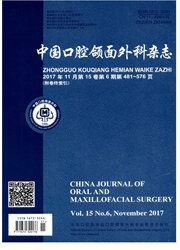

 中文摘要:
中文摘要:
目的:分析髁突囊内骨折软组织损伤的类型和自然愈合情况。方法:回顾2010—2013年收治的髁突囊内骨折(intracapsular condylar fracutre,ICF)自然愈合的患者,要求有受伤1周内及3个月以上冠状CT、MRI随访资料,利用MRI对软组织损伤进行分类和随访,包括关节盘的移位情况、下颌支残端有无关节盘覆盖、盘后区撕裂和改建情况、关节囊外侧损伤、关节腔积液等,分析软组织损伤对ICF愈合的影响。结果:12例患者的17侧髁突纳入研究。软组织损伤类型中,关节盘随髁突骨折块前移位17侧,占100%;下颌支残端有关节盘覆盖10侧,占58.8%,下颌支残端无关节盘覆盖7侧,占41.2%;盘后区撕裂11侧,占64.7%;关节囊破裂7侧,占41.2%;关节腔积液17侧,占100%。随访MRI显示,17侧关节盘位置与受伤时比较无改变;髁突表面均有新骨形成17侧,占100%;关节盘后区以增厚改建为主15侧,占88.2%;2例出现盘后区类骨样变伴撕裂,占11.8%;7侧关节囊损伤均修复;关节腔积液6侧完全吸收(35.3%)。结论:ICF软组织损伤类型有关节盘随髁突骨折块移位,盘后区撕裂,关节囊破裂和关节腔积液等。愈合方式以盘后区增厚改建、髁突表面新骨形成为主。
 英文摘要:
英文摘要:
PURPOSE: To classify soft tissue injury and evaluate its healing after intracapsular condylar fracture(ICF) of the mandible. METHODS: Patients who had less than 1 week and more than 3 months of follow-up after ICF from 2010 to 2013 were evaluated by magnetic resonance imaging(MRI) in our department. Types of soft tissue injury were classified as disc displacement with the fracture fragment, the ramus stump was or not covered by disc, status of the retrodiscal tissue(with or without tear), tears in capsule and effusion in the joint. RESULTS: Twelve patients of 17 joints were evaluated. After immediate injury, MRI showed 17(100%) discs displaced anteriorly and interiorly with the fractured fragment; ten(58.8%) discs covering the mandibular ramus, whereas 7(41.2%) were not; eleven(64.7%) tears in retrodiscal tissue; seven(41.2%) tears in capsule and all 17(100%) had joint effusions. At follow-up, seventeen(100%)had new bone formation on the condylar surface; fifteen(88.2%) had incrassation and remodeling in retrodiscal tissue, two(11.8%) had osteoid tissue hyperplasia with disc tears; six(35.3%) had joint effusions absorbed. CONCLUSIONS: Types of soft tissue injury after ICF are disc displaced anteriorly and medially with the fractured fragment, elongation of retrodiscal tissue with or without tears, tears in capsular and joint effusion. The main healing modes are retrodiscal tissue incrassation and condylar surface new bone formation.
 同期刊论文项目
同期刊论文项目
 同项目期刊论文
同项目期刊论文
 期刊信息
期刊信息
